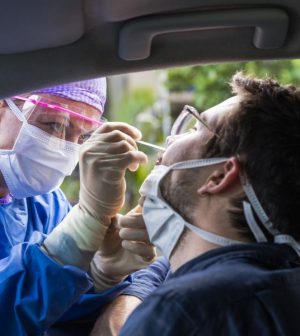- Navigating Your Midlife Crisis: Embracing New Possibilities
- City Raccoons Showing Signs of Domestication
- Mapping the Exposome: Science Broadens Focus to Environmental Disease Triggers
- One Week Less on Social Media Linked to Better Mental Health
- Your Brain Changes in Stages as You Age, Study Finds
- Some Suicide Victims Show No Typical Warning Signs, Study Finds
- ByHeart Formula Faces Lawsuits After Babies Sickened With Botulism
- Switch to Vegan Diet Could Cut Your Greenhouse Gas Emissions in Half
- Regular Bedtime Does Wonders for Blood Pressure
- Dining Alone Could Mean Worse Nutrition for Seniors
Early CDC COVID Tests Were Not Only Contaminated, But Flawed: Report

Along with being contaminated, there was also a basic design flaw in COVID-19 testing kits created by the U.S. Centers for Disease Control and Prevention early in the pandemic, a new agency review shows.
It was already known that the PCR kits were contaminated, but the CDC’s findings published Wednesday in the journal PLOS ONE are the first to note a design error that caused false positives.
When the CDC’s test kits were developed and distributed in the early weeks of the pandemic, there were no other authorized tests available.
The kits “delayed the availability of more widespread testing,” Dr. Benjamin Pinsky, the director of clinical virology for Stanford Health Care, told The New York Times. “I think it’s important that [the CDC] got to the bottom of what went wrong.”
The agency started shipping the test kits to public health laboratories in early February 2020, but many labs soon told the CDC that the tests were producing inconclusive results.
The CDC acknowledged later that month that the kits were flawed, and U.S. Food and Drug Administration officials said in April that poor manufacturing practices had caused contamination of the kits, the Times reported.
The test was originally designed to detect three regions, or sequences, of the virus’s genetic material. The kits contain a set of what are known as primers, which bind to and make copies of the regions, and probes, which produce a fluorescent signal when these copies are made, indicating that genetic material from the virus is present.
Importantly, the primers and probes need to bind to the virus’ genetic sequences and not to each other. In this case, one of the probes in the kit sometimes bound to one of the primers, producing the fluorescent signal and generating a false positive.
“It’s something that should have been caught in the design phase,” Susan Butler-Wu, a clinical microbiologist at the Keck School of Medicine of the University of Southern California, told the Times. “That’s one thing that you check for.”
The investigation also confirmed that the kits had been contaminated with synthetic fragments of the virus’s genetic material. These synthetic sequences, which are often used to ensure that the tests are working properly, were manufactured at the same CDC lab where the test kits were being tested for quality. It is “likely” that the test kits were contaminated there, the agency concluded in its report.
The production problems may have been a sign of an agency in a rush, experts noted.
“I’m not entirely surprised that they ran into some glitches right out of the gate,” Dr. Emily Volk, president of the College of American Pathologists, who also praised the agency for its transparency, told the Times. “They were asked to ramp up production in a way that I’m not sure that they had ever been asked to before.”
More information
Visit the U.S. Centers for Disease Control and Prevention for more on COVID testing.
Source: HealthDay
Copyright © 2025 HealthDay. All rights reserved.










